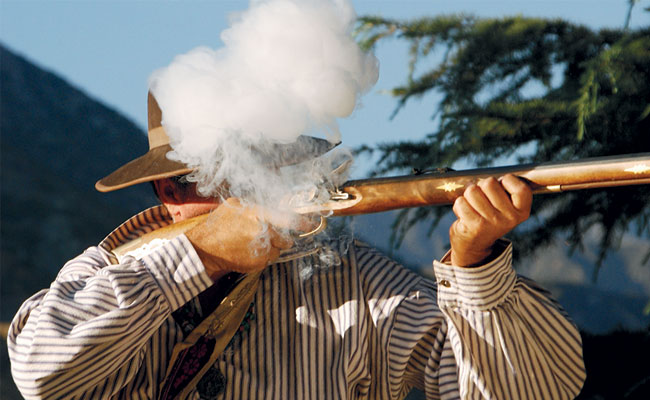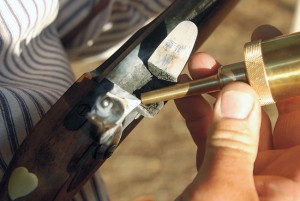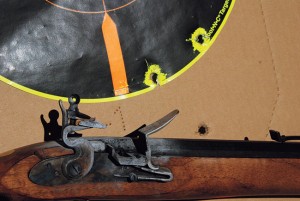December 21, 2017
By Richard Venola

In the 1992 movie Last of the Mohicans, the main character is about to provide covering fire for a courier leaving besieged Ft. William Henry. "Silk!" he says, savoring a swath of patch cloth in his hand. "It will give us another 30 yards." True or not, it invites the viewer into that special world of period muzzleloaders, where every shooter becomes his own tiny ammunition factory and ballistic scientist. It is impossible to separate history from replica firearms, and part of the charm is the sense of nostalgia they generate. Traditions is importing affordable replicas from the north of Spain so that folks curious about getting into the fun of black powder can do so without the potentially hazardous chore of telling the wife that the new carpet will have to wait until next year.
.50 PENNSYLVANIA
The Pennsylvania rifle will put you in Natty Bumppo's moccasins there on the fort wall. It's a classic 18th century long rifle with all the features: elaborate patchbox, wooden ramrod, stock embellishments and a superb set trigger. Getting used to all the variables involved, I'd recommend finding an experienced shooter and getting hands-on instruction. The next-best thing would be to actually read the instruction booklet or order the book Muzzleloading direct from Traditions.
Advertisement
 It took me a full day alone at the range with all the Traditions accessories to get things sorted out, and I've dallied with black powder before. The first thing is to keep your powder source sealed and away from all possible sources of flame or sparks. Next, avoid overfilling the pan with priming powder. And for Chingachgook's sake, wear protective eyewear. For shooters of cartridge firearms, the big poof and the ignition delay are disconcerting at first, but it's a fun learning curve in disciplining your flinch reflexes.
It took me a full day alone at the range with all the Traditions accessories to get things sorted out, and I've dallied with black powder before. The first thing is to keep your powder source sealed and away from all possible sources of flame or sparks. Next, avoid overfilling the pan with priming powder. And for Chingachgook's sake, wear protective eyewear. For shooters of cartridge firearms, the big poof and the ignition delay are disconcerting at first, but it's a fun learning curve in disciplining your flinch reflexes.
Eventually, I was able to get about a three-inch group at 55 yards using Traditions' .490 round balls and one-inch cleaning patches. An experienced Mountain Man Rendezvous reenactor could probably shrink that down considerably, and he would use mattress ticking — or maybe silk.
The stars and hearts inlaid into the stock might cause contemporary shooters some head scratching, but back in the late 1700s witchcraft and superstition were very much a concern of marksmen. These talismans were added to ward off spells that could harm the accuracy of the rifle or the health of the owner: If an accurate rifle suddenly started throwing fliers, it was a clear sign of a witch's curse. Placing the rifle in a stream of running water would isolate it from the curse and it would shoot more accurately. Hmm€¦one wonders if a little swelling of the stock might have tightened up the bedding?
Advertisement
In the days of the Pennsylvania long rifle, the quality of an arm was indicated by its patchbox, with a gentlemen's agreement that an elaborate patchbox would never be put on a modestly made rifle. The Pennsylvania's brass specimen is befitting the rifle, being handsome and well fitted but not prissy. This is a working rifle and not a cutesy wallhanger.
The rear sight is adjustable for elevation using a very fine screwdriver. The sight picture was excellent, with just enough air on either side of the front blade to see the target.
The 40-inch barrel puts some weight out at the muzzle, so you have to change your hold to properly support it, but it aids in off-hand shooting. James Fennimore Cooper wrote in Mohicans: "I tell you, Uncas, you are wasteful of your powder, and the kick of the rifle disconcerts your aim! Little powder, light lead and a long arm seldom fail of bringing the death screech from a Mingo!" The question is, Does "long arm" reference the length of the barrel (thus increasing the sight radius), or was he talking about the period technique of bracing the left arm straight out under the long fore-end?
 I took Cooper's "little powder" comment to heart and fired groups using 30 grains of Pyrodex (purists are allowed to be upset, but it was all I could find), which yielded 1,010 fps. Period Brits used a powder known as Rifle Fine Grain, or RFG, which was somewhere between today's FFFg and FFFFg. Today most folks recommend FFg down the tube and FFFFg in the priming pan.
I took Cooper's "little powder" comment to heart and fired groups using 30 grains of Pyrodex (purists are allowed to be upset, but it was all I could find), which yielded 1,010 fps. Period Brits used a powder known as Rifle Fine Grain, or RFG, which was somewhere between today's FFFg and FFFFg. Today most folks recommend FFg down the tube and FFFFg in the priming pan.
Traditions makes a wonderful little spring-loaded priming flask, but I didn't have a fine-enough powder to use with it.
A cautionary tale: When shooting off the bench, avoid placing your weak hand under the (overfilled) pan. Burning powder spills out of the pan on discharge. It's like welding splatter falling into your shoe — once it's happened there's nothing you can do about it. Leaping away from the bench and hopping about with seared fingers in your mouth is just plain undignified.
The distinctive crescent-moon brass butt is evocative of a different style of shooting. The curve was placed on the top of the arm instead of into the shoulder pocket. It takes getting used to, but it's part of the fun.
The set trigger worked perfectly, breaking cleanly at about a pound and a half. Note that neither flint nor leather flint wrapper come with the rifle. You can order them from Traditions or from Track of the Wolf or Dixie Gunworks.
To help shooters break into black powder, Traditions offers complete accessory kits with all the funnels, measures and cleaning-rod tips necessary to become your very own ammo factory.
KENTUCKY .50
If you're interested in black powder but don't have the budget for a Pennsylvania or don't want to have to master the delay of the flintlock, Traditions offers the Kentucky. A much less ornamented replica, it fits its historical niche well. Put yourself high in the Rockies with Jeremiah Johnson and Del Gue. Note: It's much easier to buy a Traditions .50 plains rifle than to wrench one out of Hatchet Jack's frozen fingers.
One of the reasons it's so hard to find an original flintlock is that so many were converted to percussion soon after the caplock's widespread introduction in the early 1830s. Percussion is so much more user-friendly, especially in bad weather. The original caps used chlorate of potash with fulminate of mercury, but most modern primers use lead azide, potassium perchlorate or lead styphnate. The Remington #11s used fit perfectly.
It has a 33½-inch barrel with the same 1:66-inch twist as the Pennsylvania, which is perfect for patched balls. Experimenting with Hornady Hard-Ball sabots, the rifle put them within 1½ inches of center but with an excessive amount of vertical spread. A later shoot with patched balls rendered a two-inch group at 55 yards. Muzzle velocity with 30 grains was 970 fps.
I preferred the single trigger of the Kentucky over that of the Pennsylvania just because I'm not used to a set trigger. This one broke with a hint of creep at about six pounds. Both rifles are imported from Spain and showed considerable hand work. Fit and finish was good, especially in areas of critical tolerance.
The only aesthetically objectionable thing about the Kentucky is that the stock is two-piece, with a brass separator. But saving huge amounts on stock wood is why Traditions can import the Kentucky at such a low price. A full-length stock requires more than twice as much wood as a two-piece, and it has to be more select. The savings are enormous.
 I tried an experiment and fed two Pyrodex pellets to the Kentucky. Six caps later they were still comfortably in a solid state. I unscrewed the cleaning-access screw in the nipple drum and dribbled in loose powder, tapping gently with the screwdriver handle to assist in the trickle-down. Next cap: boom, with a satisfying hit on the gong. Suffice it to say that pellets need more oomph than the #11s generate.
I tried an experiment and fed two Pyrodex pellets to the Kentucky. Six caps later they were still comfortably in a solid state. I unscrewed the cleaning-access screw in the nipple drum and dribbled in loose powder, tapping gently with the screwdriver handle to assist in the trickle-down. Next cap: boom, with a satisfying hit on the gong. Suffice it to say that pellets need more oomph than the #11s generate.
It's almost impossible to go broke shooting black powder (costumes and accessories are another matter), and it's as much fun and as intellectually challenging as reloading and shooting combined. It's also an excellent way to bring history into the lives of students of all ages. I'm very much looking forward to shooting the flintlock again with competition.
As for silk? According to the sage at Dixie Gunworks, "If silk patches offered even the smallest edge of advantage, everyone would be using them." But isn't it a fine idea that a beautiful woman would tear off a strip of her petticoat to try to improve your shooting?
Enjoy articles like this?
Subscribe to the magazine.
Get access to everything Guns & Ammo has to offer.
Subscribe to the Magazine
